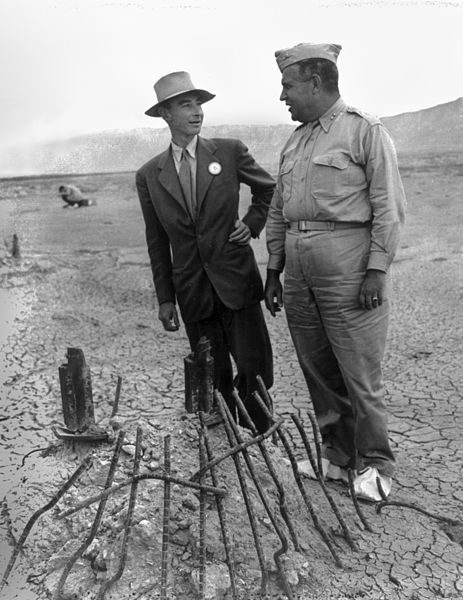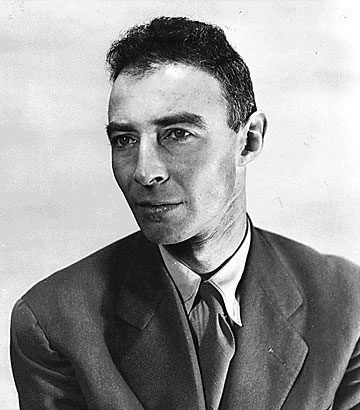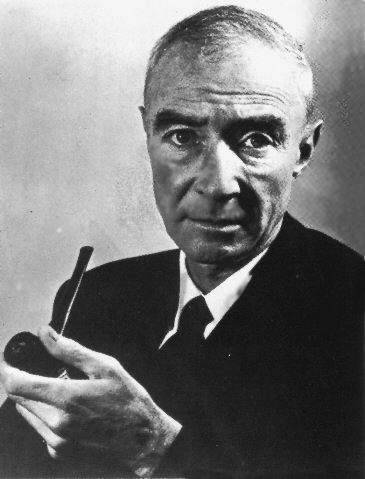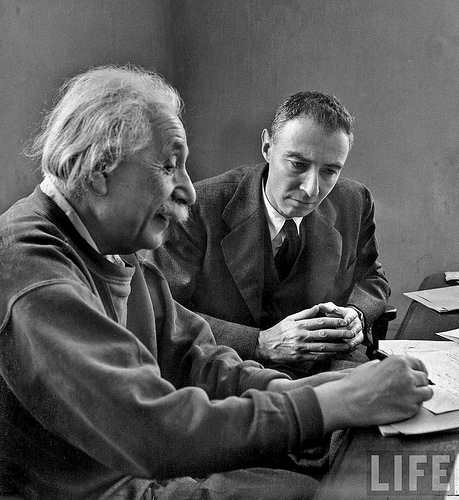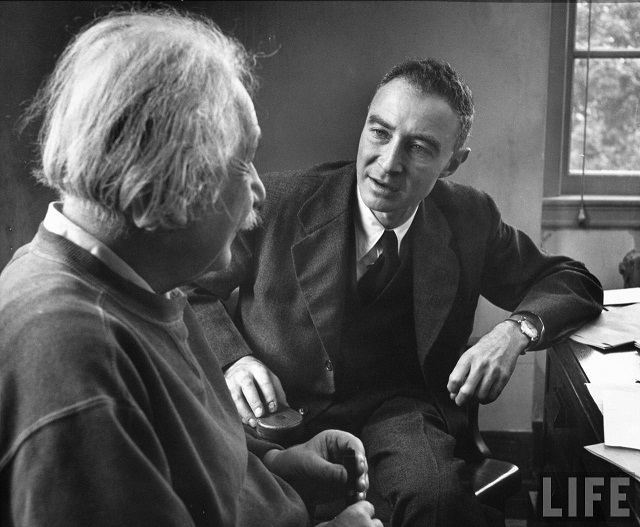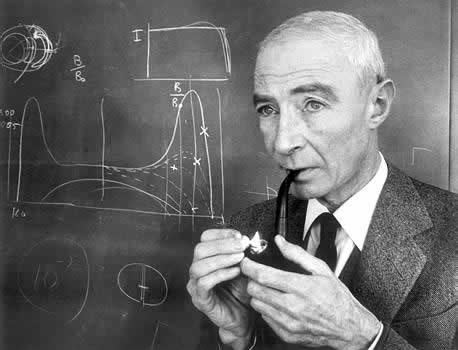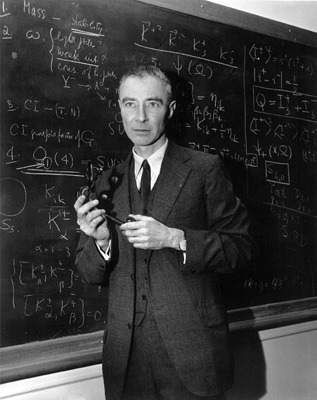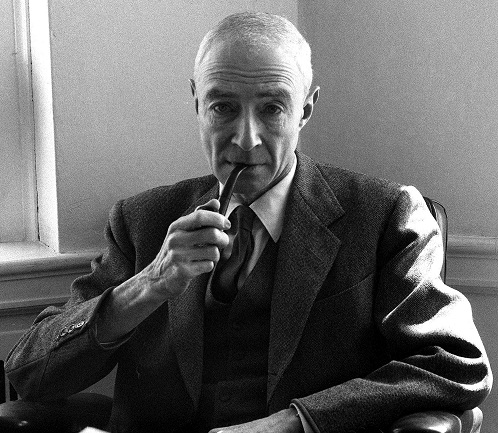<Back to Index>
- Physicist Julius Robert Oppenheimer, 1904
PAGE SPONSOR
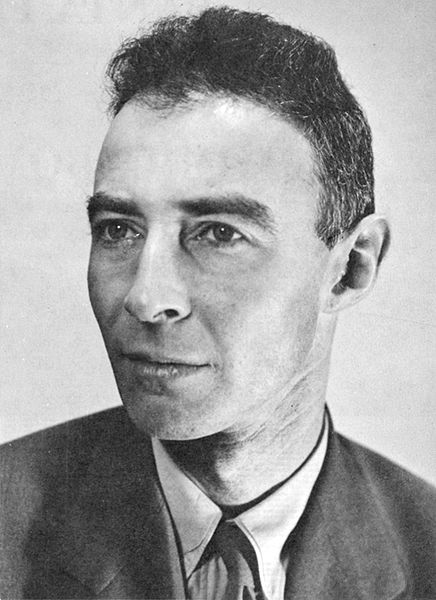
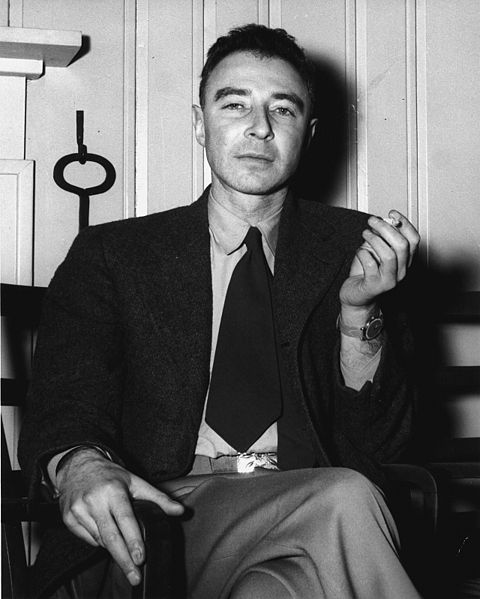
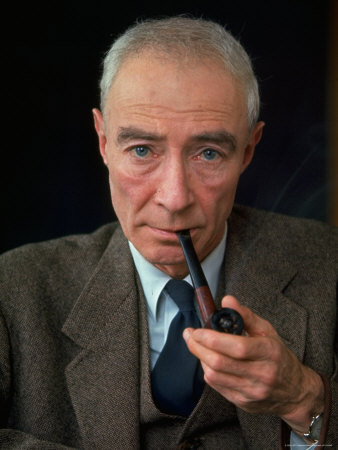
Julius Robert Oppenheimer (April 22, 1904 – February 18, 1967) was an American theoretical physicist and professor of physics at the University of California, Berkeley. Along with Enrico Fermi, he is often called the "father of the atomic bomb" for his role in the Manhattan Project, the World War II project that developed the first nuclear weapons. The first atomic bomb was detonated on July 16, 1945 in the Trinity test in New Mexico; Oppenheimer remarked later that it brought to mind words from the Bhagavad Gita: "Now, I am become Death, the destroyer of worlds."
After the war he became a chief adviser to the newly created United States Atomic Energy Commission and used that position to lobby for international control of nuclear power to avert nuclear proliferation and an arms race with the Soviet Union. After provoking the ire of many politicians with his outspoken opinions during the Second Red Scare, he had his security clearance revoked in a much publicized hearing in 1954. Though stripped of his direct political influence he continued to lecture, write and work in physics. A decade later President John F. Kennedy awarded (and Lyndon B. Johnson presented) him with the Enrico Fermi Award as a gesture of political rehabilitation.
Oppenheimer's notable achievements in physics include the Born – Oppenheimer approximation for molecular wave functions, work on the theory of electrons and positrons, the Oppenheimer – Phillips process in nuclear fusion, and the first prediction of quantum tunneling. With his students he also made important contributions to the modern theory of neutron stars and black holes, as well as to quantum mechanics, quantum field theory, and the interactions of cosmic rays.
As a teacher and promoter of science, he is remembered as a founding
father of the American school of theoretical physics that gained world
prominence in the 1930s. After World War II, he became director of the Institute for Advanced Study in Princeton.
Oppenheimer was born in New York City on April 22, 1904, to Julius S. Oppenheimer, a wealthy Jewish textile importer who had immigrated to the United States from Germany in 1888, and Ella Friedman, a painter. In 1912 the family moved to an apartment on the eleventh floor of 155 Riverside Drive, near West 88th Street, Manhattan, an area known for luxurious mansions and town houses. Their art collection included works by Pablo Picasso and Édouard Vuillard, and at least three original paintings by Vincent van Gogh. Robert had a younger brother, Frank, who also became a physicist.
Oppenheimer was initially schooled at Alcuin Preparatory School, and in 1911 entered the Ethical Culture Society School. This had been founded by Felix Adler to promote a form of ethical training based on the Ethical Culture movement, whose motto was "Deed before Creed". His father had been a member of the Society for many years, serving on its board of trustees from 1907 to 1915. Oppenheimer was a versatile scholar, interested in English and French literature, and particularly in mineralogy. He completed the third and fourth grades in one year, and skipped half the eighth grade. During his final year, he became interested in chemistry. He entered Harvard College a year late, at age 18, because he suffered an attack of colitis while prospecting in Joachimstal during a family summer vacation in Europe. To help him recover from the illness, his father enlisted the help of his English teacher Herbert Smith who took him to New Mexico, where Oppenheimer fell in love with horseback riding and the southwestern United States.
In
addition to majoring in chemistry, he was also required by Harvard's
rules to study history, literature, and philosophy or mathematics. He
made up for his late start by taking six courses each term and was
admitted to the undergraduate honor society Phi Beta Kappa.
In his first year he was admitted to graduate standing in physics on
the basis of independent study, which meant he was not required to take
the basic classes and could enroll instead in advanced ones. A course on thermodynamics taught by Percy Bridgman attracted him to experimental physics. He graduated summa cum laude in three years.
In 1924, Oppenheimer was informed that he had been accepted into Christ's College, Cambridge. He wrote to Ernest Rutherford requesting permission to work at the Cavendish Laboratory. Bridgman provided Oppenheimer with a recommendation, which conceded that Oppenheimer's clumsiness in the laboratory made it apparent his forte was not experimental but rather theoretical physics. Rutherford was unimpressed, but Oppenheimer went to Cambridge in the hope of landing another offer. He was ultimately accepted by J.J. Thomson on condition that he complete a basic laboratory course. He developed an antagonistic relationship with his tutor, Patrick Blackett, who was only a few years his senior. While on vacation, as recalled by his friend Francis Ferguson, Oppenheimer once confessed that he had left an apple doused with noxious chemicals on Blackett's desk. While Ferguson's account is the only detailed version of this event, Oppenheimer's parents were alerted by the university authorities who considered placing him on probation, a fate prevented by his parents successfully lobbying the authorities.
A tall, thin chain smoker, who often neglected to eat during periods of intense thought and concentration, Oppenheimer was marked by many of his friends as having self - destructive tendencies. A disturbing event occurred when he took a vacation from his studies in Cambridge to meet up with his friend Francis Ferguson in Paris. During a conversation in which Oppenheimer was explaining his frustration with experimental physics, he suddenly leapt up and tried to strangle Ferguson. Although Ferguson easily fended off the attack, the episode convinced him of Oppenheimer's deep psychological troubles. Plagued throughout his life by periods of depression, Oppenheimer once told his brother, "I need physics more than friends".
In 1926 he left Cambridge for the University of Göttingen to study under Max Born. Göttingen was one of the world's leading centers for theoretical physics. Oppenheimer made friends who would go on to great success, including Werner Heisenberg, Pascual Jordan, Wolfgang Pauli, Paul Dirac, Enrico Fermi and Edward Teller. He was known for being too enthusiastic in discussion, sometimes to the point of taking over seminar sessions. This irritated some of Born's other students so much that Maria Goeppert presented Born with a petition signed by herself and others threatening a boycott of the class unless he made Oppenheimer quiet down. Born left it out on his desk where Oppenheimer could read it, and it was effective without a word being said.
He obtained his Doctor of Philosophy degree in March 1927 at age 23, supervised by Born. After the oral exam, James Franck, the professor administering, reportedly said, "I'm glad that's over. He was on the point of questioning me." Oppenheimer
published more than a dozen papers at Göttingen, including many
important contributions to the new field of quantum mechanics. He and
Born published a famous paper on the Born - Oppenheimer approximation,
which separates nuclear motion from electronic motion in the
mathematical treatment of molecules, allowing nuclear motion to be
neglected to simplify calculations. It remains his most cited work.
Oppenheimer was awarded a United States National Research Council fellowship to the California Institute of Technology (Caltech) in September 1927. Bridgman also wanted him at Harvard, so a compromise was reached whereby he split his fellowship for the 1927 – 28 academic year between Harvard in 1927 and Caltech in 1928. At Caltech he struck up a close friendship with Linus Pauling, and they planned to mount a joint attack on the nature of the chemical bond, a field in which Pauling was a pioneer, with Oppenheimer supplying the mathematics and Pauling interpreting the results. Both the collaboration and their friendship were nipped in the bud when Pauling began to suspect Oppenheimer of becoming too close to his wife, Ava Helen Pauling. Once, when Pauling was at work, Oppenheimer had arrived at their home and invited Ava Helen to join him on a tryst in Mexico, though she refused and reported the incident to her husband. The invitation, and her apparent nonchalance about it, disquieted Pauling, and he ended his relationship with Oppenheimer. Oppenheimer later invited him to become head of the Chemistry Division of the Manhattan Project, but Pauling refused, saying he was a pacifist.
In the autumn of 1928, Oppenheimer visited Paul Ehrenfest's institute at the University of Leiden,
the Netherlands, where he impressed them by giving lectures in Dutch,
despite having little experience with the language. There he was given
the nickname of Opje, later Anglicized by his students as "Oppie". From Leiden he continued on to the ETH in Zurich to work with Wolfgang Pauli on quantum mechanics and the continuous spectrum.
Oppenheimer respected and liked Pauli, who may have inspired some of
Oppenheimer's own style and his critical approach to problems.
On returning to the United States, Oppenheimer accepted an associate professorship from the University of California, Berkeley, where Raymond T. Birge wanted him badly enough to offer to share him with Caltech. Before his Berkeley professorship began, Oppenheimer was diagnosed with a mild case of tuberculosis and, with his brother Frank, spent some weeks at a ranch in New Mexico, which he leased and eventually purchased. When he heard the ranch was available for lease, he exclaimed, "Hot dog!", and later called it Perro Caliente, literally "hot dog" in Spanish. Later he used to say that "physics and desert country" were his "two great loves". He recovered from the tuberculosis and returned to Berkeley, where he prospered as an adviser and collaborator to a generation of physicists who admired him for his intellectual virtuosity and broad interests. His students and colleagues saw him as mesmerizing: hypnotic in private interaction, but often frigid in more public settings. His associates fell into two camps: one that saw him as an aloof and impressive genius and aesthete, the other that saw him as a pretentious and insecure poseur. His students almost always fell into the former category, adopting his walk, speech, and other mannerisms, and even his inclination for reading entire texts in their original languages. Hans Bethe said of him:
Probably the most important ingredient he brought to his teaching was his exquisite taste. He always knew what were the important problems, as shown by his choice of subjects. He truly lived with those problems, struggling for a solution, and he communicated his concern to the group. In its heyday, there were about eight or ten graduate students in his group and about six Post - doctoral Fellows. He met this group once a day in his office, and discussed with one after another the status of the student’s research problem. He was interested in everything, and in one afternoon they might discuss quantum electrodynamics, cosmic rays, electron pair production and nuclear physics.
He worked closely with Nobel Prize winning experimental physicist Ernest O. Lawrence and his cyclotron pioneers, helping them understand the data their machines were producing at the Lawrence Berkeley National Laboratory. In
1936 Berkeley promoted him to full professor at a salary of $3,300 per
annum. In return he was asked to curtail his teaching at Caltech, so a
compromise was reached whereby Berkeley released him for six weeks each
year, enough to teach one term at Caltech.
Oppenheimer did important research in theoretical astronomy (especially as related to general relativity and nuclear theory), nuclear physics, spectroscopy, and quantum field theory, including its extension into quantum electrodynamics. The formal mathematics of relativistic quantum mechanics also attracted his attention, although he doubted its validity. His work predicted many later finds, which include the neutron, meson and neutron star.
Initially, his major interest was the theory of the continuous spectrum and his first published paper, in 1926, concerned the quantum theory of molecular band spectra. He developed a method to carry out calculations of its transition probabilities. He calculated the photoelectric effect for hydrogen and X-rays, obtaining the absorption coefficient at the K-edge. His calculations accorded with observations of the X-ray absorption of the sun, but not hydrogen. Years later it was realized that the sun was largely composed of hydrogen and that his calculations were indeed correct.
Oppenheimer also made important contributions to the theory of cosmic ray showers and started work that eventually led to descriptions of quantum tunneling. In 1931 he co-wrote a paper on the "Relativistic Theory of the Photoelectric Effect" with his student Harvey Hall, in which, based on empirical evidence, he correctly disputed Dirac's assertion that two of the energy levels of the hydrogen atom have the same energy. Subsequently, one of his doctoral students, Willis Lamb, determined that this was a consequence of the Lamb shift, for which Lamb was awarded the Nobel Prize in Physics in 1955.
Oppenheimer worked with his first doctoral student, Melba Phillips, on calculations of artificial radioactivity under bombardment by deuterons. When Ernest Lawrence and Edwin McMillan bombarded nuclei with deuterons they found the results agreed closely with the predictions of George Gamow, but when higher energies and heavier nuclei were involved, the results did not conform to the theory. In 1935, Oppenheimer and Phillips worked out a theory now known as the Oppenheimer - Phillips process to explain the results, a theory still in use today.
As early as 1930, Oppenheimer wrote a paper essentially predicting the existence of the positron, after a paper by Paul Dirac proposed that electrons could have both a positive charge and negative energy. The paper introduced the Dirac equation, a unification of quantum mechanics, special relativity and the then new concept of electron spin, to explain the Zeeman effect. Oppenheimer, drawing on the body of experimental evidence, rejected the idea that the predicted positively charged electrons were protons. He argued that they would have to have the same mass as an electron, whereas experiments showed that protons were much heavier than electrons. Two years later, Carl David Anderson discovered the positron, for which he received the 1936 Nobel Prize in Physics.
In the late 1930s, Oppenheimer became interested in astrophysics, probably through his friendship with Richard Tolman, resulting in a series of papers. In the first of these, a 1938 paper co-written with Robert Serber entitled "On the Stability of Stellar Neutron Cores", Oppenheimer explored the properties of white dwarves. This was followed by a paper co-written with one of his students, George Volkoff, "On Massive Neutron Cores", in which they demonstrated that there was a limit, the so-called Tolman - Oppenheimer - Volkoff limit, to the mass of stars beyond which they would not remain stable as neutron stars and would undergo gravitational collapse. Finally, in 1939, Oppenheimer and another of his students, Hartland Snyder, produced a paper "On Continued Gravitational Attraction", which predicted the existence of what are today known as black holes. After the Born - Oppenheimer approximation paper, these papers remain his most cited and were key factors in the rejuvenation of astrophysical research in the United States in the 1950s, mainly by John A. Wheeler.
Oppenheimer's papers were considered difficult to understand even by the standards of the abstract topics he was expert in. He was fond of using elegant, if extremely complex, mathematical techniques to demonstrate physical principles, though he was sometimes criticized for making mathematical mistakes, presumably out of haste. "His physics was good", said his student Snyder, "but his arithmetic awful."
Oppenheimer published only five scientific papers, one of which was in biophysics, after World War II, and none after 1950. Murray Gell - Mann a later Nobelist who, as a visiting scientist, worked with him at the Institute for Advanced Study in 1951, offered this opinion:
He didn't have Sitzfleisch, 'sitting flesh,' when you sit on a chair. As far as I know, he never wrote a long paper or did a long calculation, anything of that kind. He didn't have patience for that; his own work consisted of little aperçus, but quite brilliant ones. But he inspired other people to do things, and his influence was fantastic.
Oppenheimer's diverse interests sometimes interrupted his focus on projects. In 1933, he learned Sanskrit and met the Indologist Arthur W. Ryder at Berkeley. He read the Bhagavad Gita in the original language and later he cited it as one of the books that most shaped his philosophy of life. His close confidant and colleague, Nobel Prize winner Isidor Rabi, later gave his own interpretation:
Oppenheimer was overeducated in those fields, which lie outside the scientific tradition, such as his interest in religion, in the Hindu religion in particular, which resulted in a feeling of mystery of the universe that surrounded him like a fog. He saw physics clearly, looking toward what had already been done, but at the border he tended to feel there was much more of the mysterious and novel than there actually was ... [he turned] away from the hard, crude methods of theoretical physics into a mystical realm of broad intuition.
In spite of this, observers such as Nobel Prize winning physicist Luis Alvarez have suggested that if he had lived long enough to see his predictions substantiated by experiment, Oppenheimer might have won a Nobel Prize for his work on gravitational collapse, concerning neutron stars and black holes. In retrospect, some physicists and historians consider this to be his most important contribution, though it was not taken up by other scientists in his own lifetime. When the physicist and historian Abraham Pais once asked Oppenheimer what he considered to be his most important scientific contributions, Oppenheimer cited his work on electrons and positrons, not his work on gravitational contraction. Oppenheimer was nominated for the Nobel Prize for physics three times, in 1945, 1951 and 1967, but never won.
During
the 1920s, Oppenheimer remained aloof from worldly matters. He claimed
that he did not read newspapers or listen to the radio, and had only learned of the Wall Street crash of 1929 some time after it occurred. He once remarked that he never cast a vote until the 1936 election.
However, from 1934 on, he became increasingly concerned about politics
and international affairs. In 1934, he earmarked three percent of his
salary — about $100 a year — for two years to support German physicists
fleeing from Nazi Germany. During the 1934 West Coast Waterfront Strike, he and some of his students, including Melba Phillips and Bob Serber,
attended a longshoremen's rally. Oppenheimer repeatedly attempted to get
Serber a position at Berkeley but was blocked by Birge, who felt that
"one Jew in the department was enough".
Oppenheimer's mother died in 1931, and he became closer to his father who, although still living in New York, became a frequent visitor in California. When his father died in 1937 leaving $ 392,602 to be divided between Oppenheimer and his brother Frank, Oppenheimer immediately wrote out a will leaving his estate to the University of California for graduate scholarships. Like many young intellectuals in the 1930s, he was a supporter of social reforms that were later alleged to be communist ideas. He donated to many progressive efforts which were later branded as "left - wing" during the McCarthy era. The majority of his allegedly radical work consisted of hosting fund raisers for the Republican cause in the Spanish Civil War and other anti - fascist activity. He never openly joined the Communist Party, though he did pass money to liberal causes by way of acquaintances who were alleged to be Party members. In 1936, Oppenheimer became involved with Jean Tatlock, the daughter of a Berkeley literature professor and a student at Stanford University School of Medicine. The two had similar political views; she wrote for the Western Worker, a Communist Party newspaper.
Oppenheimer broke up with Tatlock in 1939. In August that year he met Katherine ("Kitty") Puening Harrison, a radical Berkeley student and former Communist Party member. Harrison had been married three times previously. Her first marriage lasted only a few months. Her second husband was Joe Dallet, an active member of the Communist party, who was killed in the Spanish Civil War. Kitty returned to the United States where she obtained a bachelor of arts degree in botany from the University of Pennsylvania. There she married Richard Harrison, a physician and medical researcher, in 1938. In June 1939 Kitty and Harrison moved to Pasadena, California, where he became chief of radiology at a local hospital and she enrolled as a graduate student at the University of California, Los Angeles. Oppenheimer and Kitty created a minor scandal by sleeping together after one of Tolman's parties. In the summer of 1940 she stayed with Oppenheimer at his ranch in New Mexico. She finally asked Harrison for a divorce when she found out she was pregnant. When he refused, she obtained an instant divorce in Reno, Nevada, and married Oppenheimer on November 1, 1940.
Their first child Peter was born in May 1941, and their second child, Katherine ("Toni"), was born in Los Alamos, New Mexico, on December 7, 1944. During his marriage, Oppenheimer continued his affair with Jean Tatlock. Later their continued contact became an issue in his security clearance hearings because of Tatlock's Communist associations. Many of Oppenheimer's closest associates were active in the Communist Party in the '30s or '40s. They included his brother Frank, Frank's wife Jackie, Kitty, Jean Tatlock, his landlady Mary Ellen Washburn, and several of his graduate students at Berkeley.
When he joined the Manhattan Project in 1942, Oppenheimer wrote on his personal security questionnaire that he [Oppenheimer] had been "a member of just about every Communist Front organization on the West Coast". Years later he claimed that he did not remember saying this, that it was not true, and that if he had said anything along those lines, it was "a half - jocular overstatement". He was a subscriber to the People's World, a Communist Party organ, and he testified in 1954, "I was associated with the Communist movement." From 1937 to 1942, in the midst of the Great Purge and Hitler - Stalin pact, Oppenheimer was a member at Berkeley of what he called a "discussion group", which was later identified by fellow members, Haakon Chevalier and Gordon Griffiths, as a "closed" (secret) unit of the Communist Party for Berkeley faculty.
The Federal Bureau of Investigation (FBI) recorded that J. Robert Oppenheimer attended a meeting in the home of self - proclaimed Communist Haakon Chevalier, that the Communist Party's California state chairman William Schneiderman, and Isaac Folkoff, West Coast liaison between the Communist Party and NKVD, attended in Fall 1940, during the Hitler - Stalin pact. Shortly thereafter, the FBI added Oppenheimer to its Custodial Detention Index, for arrest in case of national emergency, and listed him as "Nationalistic Tendency: Communist". Debates over Oppenheimer's Party membership or lack thereof have turned on very fine points; almost all historians agree he had strong socialist sympathies during this time and interacted with Party members, though there is considerable dispute over whether he was officially a member of the Party. At his 1954 security clearance hearings, he denied being a member of the Communist Party, but identified himself as a fellow traveler, which he defined as someone who agrees with many of the goals of Communism, but without being willing to blindly follow orders from any Communist party apparatus.
Throughout the development of the atomic bomb, Oppenheimer was under investigation by both the FBI and the Manhattan Project's internal security arm for his past left wing associations. He was followed by Army security agents during a trip to California in June 1943 to visit his former girlfriend, Jean Tatlock, who was suffering from depression. Oppenheimer spent the night in her apartment. Jean committed suicide on January 4, 1944, which left Oppenheimer deeply grieved. In August 1943, he volunteered to Manhattan Project security agents that George Eltenton, whom he did not know, had solicited three men at Los Alamos for nuclear secrets on behalf of the Soviet Union. When pressed on the issue in later interviews, Oppenheimer admitted that the only person who had approached him was his friend Haakon Chevalier, a Berkeley professor of French literature, who had mentioned the matter privately at a dinner at Oppenheimer's house. Groves thought Oppenheimer was too important to the project to oust him over this suspicious behavior. On July 20, 1943, he wrote to the Manhattan Engineer District:
In accordance with my verbal directions of July 15, it is desired that clearance be issued to Julius Robert Oppenheimer without delay irrespective of the information which you have concerning Mr Oppenheimer. He is absolutely essential to the project.
In June 1942, the US Army established the Manhattan Engineer District to handle its part in the atom bomb project, beginning the process of transferring responsibility from the Office of Scientific Research and Development to the military. In September, Brigadier General Leslie R. Groves, Jr., was appointed director of what became known as the Manhattan Project. Groves, in turn, selected Oppenheimer to head the project's secret weapons laboratory. Groves' choice surprised many, as Oppenheimer was not known to be politically aligned with the conservative military, nor to be an efficient leader of large projects. The fact that he did not have a Nobel Prize, and might not have the prestige to direct fellow scientists, did concern Groves. However, he was impressed by Oppenheimer's singular grasp of the practical aspects of designing and constructing an atomic bomb, and by the breadth of his knowledge. As a military engineer, Groves knew that this would be vital in an interdisciplinary project that would involve not just physics, but chemistry, metallurgy, ordnance and engineering. Groves also detected in Oppenheimer something that many others did not, an "overweening ambition" that Groves reckoned would supply the drive necessary to push the project to a successful conclusion. Isidor Rabi considered the appointment "a real stroke of genius on the part of General Groves, who was not generally considered to be a genius".
Oppenheimer and Groves decided that for security and cohesion they needed a centralized, secret research laboratory in a remote location. Scouting for a site in late 1942, Oppenheimer was drawn to New Mexico, not far from his ranch. On November 16, 1942, Oppenheimer, Groves and others toured a prospective site. Oppenheimer feared that the high cliffs surrounding the site would make his people feel claustrophobic, while the engineers were concerned with the possibility of flooding. He then suggested and championed a site that he knew well: a flat mesa near Santa Fe, New Mexico, which was the site of a private boys' school called the Los Alamos Ranch School. The engineers were concerned about the poor access road and the water supply, but otherwise felt that it was ideal. The Los Alamos laboratory was built on the site of the school, taking over some of its buildings, while many others were erected in great haste. There Oppenheimer assembled a group of the top physicists of the time, which he referred to as the "luminaries".
Initially Los Alamos was supposed to be a military laboratory, and Oppenheimer and other researchers were to be commissioned into the Army. He went so far as to order himself a lieutenant colonel's uniform and take the Army physical test, which he failed. Army doctors considered him underweight at 128 pounds (58 kg), diagnosed his chronic cough as tuberculosis and were concerned about his chronic lumbosacral joint pain. The plan to commission scientists fell through when Robert Bacher and Isidor Rabi balked at the idea. Conant, Groves and Oppenheimer devised a compromise whereby the laboratory was operated by the University of California under contract to the War Department. It soon turned out that Oppenheimer's estimates of the size of the project were extraordinarily optimistic. Los Alamos grew from a few hundred people in 1943 to over 6,000 in 1945.
Oppenheimer at first had difficulty with the organizational division of large groups, but rapidly learned the art of large scale administration after he took up permanent residence on the mesa. He was noted for his mastery of all scientific aspects of the project and for his efforts to control the inevitable cultural conflicts between scientists and the military. He was an iconic figure to his fellow scientists, as much a symbol of what they were working toward as a scientific director. Victor Weisskopf put it thus:
Oppenheimer directed these studies, theoretical and experimental, in the real sense of the words. Here his uncanny speed in grasping the main points of any subject was a decisive factor; he could acquaint himself with the essential details of every part of the work. He did not direct from the head office. He was intellectually and even physically present at each decisive step. He was present in the laboratory or in the seminar rooms, when a new effect was measured, when a new idea was conceived. It was not that he contributed so many ideas or suggestions; he did so sometimes, but his main influence came from something else. It was his continuous and intense presence, which produced a sense of direct participation in all of us; it created that unique atmosphere of enthusiasm and challenge that pervaded the place throughout its time.
In 1943, development efforts were directed to a plutonium gun - type fission weapon called "Thin Man". Initial research on the properties of plutonium was done using cyclotron - generated plutonium - 239, which was extremely pure, but could only be created in tiny amounts. When Los Alamos received the first sample of plutonium from the X-10 Graphite Reactor in April 1944 a problem was discovered: reactor - bred plutonium had a higher concentration of plutonium - 240, making it unsuitable for use in a gun - type weapon. In July 1944, Oppenheimer abandoned the gun design in favor of an implosion - type weapon. Using chemical explosive lenses, a sub - critical sphere of fissile material could be squeezed into a smaller and denser form. The metal needed to travel only very short distances, so the critical mass would be assembled in much less time. In August 1944, Oppenheimer implemented a sweeping reorganization of the Los Alamos laboratory to focus on implosion. He concentrated the development efforts on the gun - type device, a simpler design that only had to work with uranium - 235, in a single group, and this device became Little Boy in February 1945. After a mammoth research effort, the more complex design of the implosion device, known as the "Christy gadget" after Robert Christy, another student of Oppenheimer's, was finalized in a meeting in Oppenheimer's office on February 28, 1945.
In May 1945, an Interim Committee was
created to advise and report on wartime and postwar policies regarding
the use of nuclear energy. The Interim Committee in turn established a
scientific panel consisting of Compton,
Fermi, Lawrence and Oppenheimer to advise it on scientific issues. In
its presentation to the Interim Committee, the scientific panel offered
its opinion not just on the likely physical effects of an atomic bomb, but on its likely military and political impact. This
included opinions on such sensitive issues as whether or not the Soviet
Union should be advised of the weapon in advance of its use against
Japan.
The joint work of the scientists at Los Alamos resulted in the first artificial nuclear explosion near Alamogordo on July 16, 1945, on a site that Oppenheimer codenamed "Trinity" in mid 1944. He later said this name was from one of John Donne's Holy Sonnets. According to the historian Gregg Herken, this naming could have been an allusion to Jean Tatlock, who had committed suicide a few months previously and had in the 1930s introduced Oppenheimer to Donne's work. Oppenheimer later recalled that, while witnessing the explosion, he thought of a verse from the Hindu holy book, the Bhagavad Gita:
If the radiance of a thousand suns were to burst at once into the sky, that would be like the splendor of the mighty one ...
Years later he would explain that another verse had also entered his head at that time: namely, the famous verse: "kālo'smi lokakṣayakṛtpravṛddho lokānsamāhartumiha pravṛttaḥ", which he translated as "I am become Death, the destroyer of worlds."
In 1965, he was persuaded to quote again for a television broadcast:
We knew the world would not be the same. A few people laughed, a few people cried. Most people were silent. I remembered the line from the Hindu scripture, the Bhagavad - Gita; Vishnu is trying to persuade the Prince that he should do his duty and, to impress him, takes on his multi - armed form and says, 'Now I am become Death, the destroyer of worlds.' I suppose we all thought that, one way or another.'
According to his brother, at the time Oppenheimer simply exclaimed, "It worked." A contemporary account by Brigadier General Thomas Farrell, who was present in the control bunker at the site with Oppenheimer, summarized his reaction as follows:
Dr. Oppenheimer, on whom had rested a very heavy burden, grew tenser as the last seconds ticked off. He scarcely breathed. He held on to a post to steady himself. For the last few seconds, he stared directly ahead and then when the announcer shouted "Now!" and there came this tremendous burst of light followed shortly thereafter by the deep growling roar of the explosion, his face relaxed into an expression of tremendous relief.
For his services as director of Los Alamos, Oppenheimer was awarded the Presidential Medal for Merit in 1946.
After the atomic bombings of Hiroshima and Nagasaki,
the Manhattan Project became public knowledge and Oppenheimer became a
national spokesman for science, emblematic of a new type of technocratic
power. He became a household name and his face appeared on the covers of Life and Time. Nuclear
physics became a powerful force as all governments of the world began
to realize the strategic and political power that came with nuclear
weapons. Like many scientists of his generation, he felt that security
from atomic bombs would come only from a transnational organization such
as the newly formed United Nations, which could institute a program to stifle a nuclear arms race.
In November 1945, Oppenheimer left Los Alamos to return to Caltech, but he soon found that his heart was no longer in teaching. In 1947, he accepted an offer from Lewis Strauss to take up the directorship of the Institute for Advanced Study in Princeton, New Jersey.
This meant moving back east and leaving Ruth Tolman, the wife of his
friend Richard Tolman, with whom he had begun an affair after leaving
Los Alamos. The job came with a salary of $20,000 per annum, plus rent - free
accommodation in the director's house, a 17th century manor with a cook
and groundskeeper, surrounded by 265 acres (107 ha) of woodlands.
Oppenheimer brought together intellectuals at the height of their powers and from a variety of disciplines to solve the most pertinent questions of the age. He directed and encouraged the research of many well known scientists, including Freeman Dyson, and the duo of Chen Ning Yang and Tsung - Dao Lee, who won a Nobel Prize for their discovery of parity non - conservation. He also instituted temporary memberships for scholars from the humanities, such as T.S. Eliot and George F. Kennan. Some of these activities were resented by a few members of the mathematics faculty, who wanted the institute to stay a bastion of pure scientific research. Abraham Pais said that Oppenheimer himself thought that one of his failures at the institute was being unable to bring together scholars from the natural sciences and the humanities.
A
series of conferences in New York from 1947 through 1949 saw physicists
switch back from war work to theoretical issues. Under Oppenheimer's
direction, physicists tackled the greatest outstanding problem of the
pre - war years: infinite, divergent, and non - sensical expressions in
the quantum electrodynamics of elementary particles. Julian Schwinger, Richard Feynman and Shin'ichiro Tomonaga tackled the problem of regularization, and developed techniques which became known as renormalization. Freeman Dyson was able to prove that their procedures gave similar results. The problem of meson absorption and Hideki Yukawa's theory of mesons as the carrier particles of the strong nuclear force were also tackled. Probing questions from Oppenheimer prompted Robert Marshak's innovative two - meson hypothesis: that there were actually two types of mesons, pions and muons. This led to Cecil Frank Powell's breakthrough and subsequent Nobel Prize for the discovery of the pion.
As a member of the Board of Consultants to a committee appointed by President Harry S. Truman, Oppenheimer strongly influenced the Acheson – Lilienthal Report.
In this report, the committee advocated creation of an international
Atomic Development Authority, which would own all fissionable material
and the means of its production, such as mines and laboratories, and
atomic power plants where it could be used for peaceful energy
production. Bernard Baruch was appointed to translate this report into a proposal to the United Nations, resulting in the Baruch Plan of
1946. The Baruch Plan introduced many additional provisions regarding
enforcement, in particular requiring inspection of the Soviet Union's
uranium resources. The Baruch Plan was seen as an attempt to maintain
the United States' nuclear monopoly and was rejected by the Soviets.
With this, it became clear to Oppenheimer that an arms race was
unavoidable, due to the mutual suspicion of the United States and the
Soviet Union, which even Oppenheimer was starting to distrust.
After the Atomic Energy Commission (AEC) came into being in 1947 as a civilian agency in control of nuclear research and weapons issues, Oppenheimer was appointed as the Chairman of its General Advisory Committee (GAC). From this position he advised on a number of nuclear - related issues, including project funding, laboratory construction and even international policy — though the GAC's advice was not always heeded. As Chairman of the GAC, Oppenheimer lobbied vigorously for international arms control and funding for basic science, and attempted to influence policy away from a heated arms race. When the government questioned whether to pursue a crash program to develop an atomic weapon based on nuclear fusion — the hydrogen bomb — Oppenheimer initially recommended against it, though he had been in favor of developing such a weapon during the Manhattan Project. He was motivated partly by ethical concerns, feeling that such a weapon could only be used strategically against civilian targets, resulting in millions of deaths. He was also motivated by practical concerns, however, as at the time there was no workable design for a hydrogen bomb. Oppenheimer felt that resources would be better spent creating a large force of fission weapons. He and others were especially concerned about nuclear reactors being diverted from plutonium to tritium production. They were overridden by Truman, who announced a crash program after the Soviet Union tested their first atomic bomb in 1949. Oppenheimer and other GAC opponents of the project, especially James Conant, felt personally shunned and considered retiring from the committee. They stayed on, though their views on the hydrogen bomb were well known.
In 1951, however, Edward Teller and mathematician Stanislaw Ulam developed what became known as the Teller - Ulam design for a hydrogen bomb. This new design seemed technically feasible and Oppenheimer changed his opinion about developing the weapon. As he later recalled:
The program we had in 1949 was a tortured thing that you could well argue did not make a great deal of technical sense. It was therefore possible to argue that you did not want it even if you could have it. The program in 1951 was technically so sweet that you could not argue about that. The issues became purely the military, the political and the humane problems of what you were going to do about it once you had it.
On June 7, 1949, Oppenheimer testified before the House Un-American Activities Committee, where he admitted that he had associations with the Communist Party in the 1930s. He testified that some of his students, including David Bohm, Giovanni Rossi Lomanitz, Philip Morrison, Bernard Peters and Joseph Weinberg, had been Communists at the time they had worked with him at Berkeley. Frank Oppenheimer and his wife Jackie testified before the HUAC and admitted that they had been members of the Communist Party. Frank was subsequently fired from his University of Michigan position. Unable to find work in physics for many years, he became instead a cattle rancher in Colorado. He later taught high school physics and was the founder of the San Francisco Exploratorium.
Oppenheimer had found himself in the middle of more than one controversy and power struggle in the years from 1949 to 1953. Edward Teller, who had been so uninterested in work on the atomic bomb at Los Alamos during the war that Oppenheimer had given him time instead to work on his own project of the hydrogen bomb, had eventually left Los Alamos to help found, in 1951, a second laboratory at what would become the Lawrence Livermore National Laboratory. There, he could be free of Los Alamos control to develop the hydrogen bomb. Long - range thermonuclear "strategic" weapons delivered by jet bombers would necessarily be under control of the new United States Air Force (USAF). Oppenheimer had for some years pushed for smaller "tactical" nuclear weapons which would be more useful in a limited theater against enemy troops and which would be under control of the Army. The two services fought for control of nuclear weapons, often allied with different political parties. The USAF, with Teller pushing its program, gained ascendance in the Republican controlled administration following the election of Dwight D. Eisenhower as president in 1952.
In
1950, Paul Crouch, Communist Party organizer for Alameda County from
April 1941 to early January 1942, was the first person to accuse
Oppenheimer of Communist Party ties. He
testified before a Congressional committee that Oppenheimer had hosted a
Communist Party meeting at his Berkeley home. The charges were widely
publicized at the time. However,
Oppenheimer was able to prove that he was in New Mexico at the time and
Crouch over time was shown to be an unreliable informant. In
November 1953, J. Edgar Hoover was sent a letter concerning Oppenheimer
by William Liscum Borden, former executive director of Congress' Joint
Atomic Energy Committee. In the letter, Borden stated his opinion "based
upon years of study, of the available classified evidence, that more
probably than not J. Robert Oppenheimer is an agent of the Soviet
Union."
Strauss and Senator Brien McMahon, author of the 1946 McMahon Act, pushed Eisenhower to revoke Oppenheimer's security clearance. On December 21, 1953, Lewis Strauss told Oppenheimer that his security clearance had been suspended, pending resolution of a series of charges outlined in a letter, and discussed his resigning. Oppenheimer chose not to resign and requested a hearing instead. The charges were outlined in a letter from Kenneth D. Nichols, General Manager of the AEC. The hearing that followed in April – May 1954, which was initially confidential and not made public, focused on Oppenheimer's past Communist ties and his association during the Manhattan Project with suspected disloyal or Communist scientists. One of the key elements in this hearing was Oppenheimer's earliest testimony about George Eltenton's approach to various Los Alamos scientists, a story that Oppenheimer confessed he had fabricated to protect his friend Haakon Chevalier. Unknown to Oppenheimer, both versions were recorded during his interrogations of a decade before. He was surprised on the witness stand with transcripts of these, which he had not been given a chance to review. In fact, Oppenheimer had never told Chevalier that he had finally named him, and the testimony had cost Chevalier his job. Both Chevalier and Eltenton confirmed mentioning that they had a way to get information to the Soviets, Eltenton admitting he said this to Chevalier and Chevalier admitting he mentioned it to Oppenheimer, but both put the matter in terms of gossip and denied any thought or suggestion of treason or thoughts of espionage, either in planning or in deed. Neither was ever convicted of any crime.
Teller testified against Oppenheimer, saying that he considered him loyal, but of such questionable judgment that he should be relieved of clearance on the basis of bad decision making. This led to outrage by the scientific community and Teller's virtual expulsion from academic science. Groves, threatened by the FBI as having been potentially part of a coverup about the Chevalier contact in 1943, likewise testified against Oppenheimer. Many top scientists, as well as government and military figures, testified on Oppenheimer's behalf. Inconsistencies in his testimony and his erratic behavior on the stand, at one point saying he had given a "cock and bull story" and that this was because he "was an idiot", convinced some that he was unstable, unreliable and a possible security risk. Oppenheimer's clearance was revoked one day before it was slated to lapse anyway. Isidor Rabi's comment was that Oppenheimer was merely a government consultant at the time anyway and that if the government "didn't want to consult the guy, then don't consult him."
During his hearing, Oppenheimer testified willingly on the left wing behavior of many of his scientific colleagues. Had Oppenheimer's clearance not been stripped then he might have been remembered as someone who had "named names" to save his own reputation. As it happened, Oppenheimer was seen by most of the scientific community as a martyr to McCarthyism, an eclectic liberal who was unjustly attacked by warmongering enemies, symbolic of the shift of scientific creativity from academia into the military. Wernher von Braun summed up his opinion about the matter with a quip to a Congressional committee: "In England, Oppenheimer would have been knighted."
In a seminar at the Woodrow Wilson Institute on May 20, 2009, based on an extensive analysis of the Vassiliev notebooks taken from the KGB archives, John Earl Haynes, Harvey Klehr and Alexander Vassiliev confirmed that Oppenheimer never was involved in espionage for the Soviet Union. The KGB tried repeatedly to recruit him, but was never successful; Oppenheimer did not betray the United States. In addition, he had several persons removed from the Manhattan project who had sympathies to the Soviet Union.
Starting in 1954, Oppenheimer spent several months of the year living on the island of St. John in the Virgin Islands. In 1957, he purchased a 2 acre (0.81 ha) tract of land on Gibney Beach, where he built a spartan home on the beach. He spent a considerable amount of time sailing with his daughter Toni and wife Kitty.
Increasingly concerned about the potential danger to humanity arising from scientific discoveries, Oppenheimer joined with Albert Einstein, Bertrand Russell, Joseph Rotblat and other eminent scientists and academics to establish what would eventually become the World Academy of Art and Science in 1960. Significantly, after his public humiliation, he did not sign the major open protests against nuclear weapons of the 1950s, including the Russell – Einstein Manifesto of 1955, nor, though invited, did he attend the first Pugwash Conferences on Science and World Affairs in 1957.
However,
in his speeches and public writings, Oppenheimer continually stressed
the difficulty of managing the power of knowledge in a world in which
the freedom of science to exchange ideas was more and more hobbled by
political concerns. Oppenheimer delivered the Reith Lectures on the BBC in 1953, which were subsequently published as Science and the Common Understanding. In 1955 Oppenheimer published The Open Mind,
a collection of eight lectures that he had given since 1946 on the
subject of nuclear weapons and popular culture. Oppenheimer rejected the
idea of nuclear gunboat diplomacy. "The purposes of this country in the
field of foreign policy," he wrote, "cannot in any real or enduring way
be achieved by coercion." In 1957 the philosophy and psychology
departments at Harvard invited Oppenheimer to deliver the William James Lectures. An influential group of Harvard alumni led by Edwin Ginn that included Archibald Roosevelt protested against the decision. Some 1,200 people packed into Sanders Theatre to hear Oppenheimer's six lectures, entitled "The Hope of Order". Oppenheimer delivered the Whidden Lectures at McMaster University in 1962, and these were published in 1964 as The Flying Trapeze: Three Crises for Physicists.
Deprived of political power, Oppenheimer continued to lecture, write and work on physics. He toured Europe and Japan, giving talks about the history of science, the role of science in society, and the nature of the universe. In September 1957, France made him an Officer of the Legion of Honor, and on May 3, 1962, he was elected a Foreign Member of the Royal Society in Britain. At the urging of many of Oppenheimer's political friends who had ascended to power, President John F. Kennedy awarded Oppenheimer the Enrico Fermi Award in 1963 as a gesture of political rehabilitation. Edward Teller, the winner of the previous year's award, had also recommended Oppenheimer receive it, in the hope that it would heal the rift between them. A little over a week after Kennedy's assassination, his successor, President Lyndon Johnson, presented Oppenheimer with the award, "for contributions to theoretical physics as a teacher and originator of ideas, and for leadership of the Los Alamos Laboratory and the atomic energy program during critical years." Oppenheimer told Johnson: "I think it is just possible, Mr. President, that it has taken some charity and some courage for you to make this award today." The rehabilitation implied by the award was partly symbolic, as Oppenheimer still lacked a security clearance and could have no effect on official policy, but the award came with a $50,000 tax - free stipend, and its award outraged many prominent Republicans in Congress. The late President Kennedy's widow Jacqueline, still living in the White House, made it a point to meet with Oppenheimer to tell him how much her husband had wanted him to have the medal. While still a senator in 1959, Kennedy had been instrumental in voting to narrowly deny Oppenheimer's enemy Lewis Strauss a coveted government position as Secretary of Commerce, effectively ending Strauss' political career. This was partly due to lobbying by the scientific community on behalf of Oppenheimer.
A chain smoker since early adulthood, Oppenheimer was diagnosed with throat cancer in late 1965 and, after inconclusive surgery, underwent unsuccessful radiation treatment and chemotherapy late in 1966. He fell into a coma on February 15, 1967, and died at his home in Princeton, New Jersey, on February 18, aged 62. A memorial service was held at Alexander Hall at Princeton University a week later, which was attended by 600 of his scientific, political and military associates, including Bethe, Groves, Kennan, Lilienthal, Rabi, Smyth and Wigner. His brother Frank and the rest of his family were there, as was the historian Arthur Meier Schlesinger Jr., the novelist John O'Hara, and George Balanchine, the director of the New York City Ballet. Bethe, Kennan and Smyth gave brief eulogies. Oppenheimer was cremated and his ashes were placed in an urn. Kitty took his ashes to St. John and dropped the urn into the sea off the coast, within sight of the beach house.
Upon the death of Kitty Oppenheimer, who died of an intestinal infection complicated by pulmonary embolism in October 1972, Oppenheimer's ranch in New Mexico was inherited by their son Peter, and the beach property was inherited by their daughter Toni. Toni was refused security clearance for her chosen vocation as a United Nations translator after the FBI brought up the old charges against her father. Three months following the end of her second marriage, she committed suicide by hanging in the beach house in January 1977 and left it in her will to "the people of St. John for a public park and recreation area." The original house, built too close to the coast, succumbed to a hurricane, but today, the Virgin Islands Government maintains a Community Center in the area.
When
Oppenheimer was ejected from his position of political influence in
1954, he symbolized for many the folly of scientists thinking they could
control how others would use their research. He has also been seen as
symbolizing the dilemmas involving the moral responsibility of the
scientist in the nuclear world. The
hearings were motivated both by politics, as Oppenheimer was seen as a
representative of the previous administration, and by personal
considerations stemming from his enmity with Lewis Strauss. The
ostensible reason for the hearing and the issue that aligned
Oppenheimer with the liberal intellectuals, Oppenheimer's opposition to
hydrogen bomb development, was based as much on technical grounds as on
moral ones. Once the technical considerations were resolved, he supported Teller's hydrogen bomb because he believed that the Soviet Union would inevitably construct one too. Rather
than consistently oppose the "Red - baiting" of the late 1940s and
early 1950s, Oppenheimer testified against some of his former colleagues
and
students, both before and during his hearing. In one incident, his
damning testimony against former student Bernard Peters was selectively
leaked to the press. Historians have interpreted this as an attempt by
Oppenheimer to please his colleagues in the government and perhaps to
divert attention from his own previous left wing ties and those of his
brother. In the end it became a liability when it became clear that if
Oppenheimer had really doubted Peters' loyalty, his recommending him for
the Manhattan Project was reckless, or at least contradictory.
Popular depictions of Oppenheimer view his security struggles as a confrontation between right wing militarists (symbolized by Teller) and left wing intellectuals (symbolized by Oppenheimer) over the moral question of weapons of mass destruction. The question of the scientists' responsibility toward humanity inspired Bertolt Brecht's drama Galileo (1955), left its imprint on Friedrich Dürrenmatt's Die Physiker, and is the basis of the opera Doctor Atomic by John Adams (2005), which was commissioned to portray Oppenheimer as a modern day Faust. Heinar Kipphardt's play In the Matter of J. Robert Oppenheimer, after appearing on West German television, had its theatrical release in Berlin and Munich in October 1964. Oppenheimer's objections resulted in an exchange of correspondence with Kipphardt, in which the playwright offered to make corrections but defended the play. It premiered in New York in June 1968, with Joseph Wiseman in the Oppenheimer role. New York Times theater critic Clive Barnes called it an "angry play and a partisan play" that sided with Oppenheimer but portrayed the scientist as a "tragic fool and genius". Oppenheimer had difficulty with this portrayal. After reading a transcript of Kipphardt's play soon after it began to be performed, Oppenheimer threatened to sue the playwright, decrying "improvisations which were contrary to history and to the nature of the people involved." Later Oppenheimer told an interviewer:
The whole damn thing [his security hearing] was a farce, and these people are trying to make a tragedy out of it. ... I had never said that I had regretted participating in a responsible way in the making of the bomb. I said that perhaps he [Kipphardt] had forgotten Guernica, Coventry, Hamburg, Dresden, Dachau, Warsaw, and Tokyo; but I had not, and that if he found it so difficult to understand, he should write a play about something else.
The 1980 BBC TV serial Oppenheimer, starring Sam Waterston, won three BAFTA Television Awards. The Day After Trinity, a 1980 documentary about J. Robert Oppenheimer and the building of the atomic bomb, was nominated for an Academy Award and received a Peabody Award. In addition to his use by authors of fiction, Oppenheimer's life has been explored in numerous biographies, including American Prometheus: The Triumph and Tragedy of J. Robert Oppenheimer (2005) by Kai Bird and Martin J. Sherwin which won the Pulitzer Prize for Biography or Autobiography for 2006. A centennial conference and exhibit were held in 2004 at Berkeley, with the proceedings of the conference published in 2005 as Reappraising Oppenheimer: Centennial Studies and Reflections. His papers are in the Library of Congress.
As a scientist, Oppenheimer is remembered by his students and colleagues as being a brilliant researcher and engaging teacher, the founder of modern theoretical physics in the United States. Because his scientific attentions often changed rapidly, he never worked long enough on any one topic to merit the Nobel Prize, although his investigations contributing to the theory of black holes may have warranted the prize had he lived long enough to see them brought into fruition by later astrophysicists. An asteroid, 67085 Oppenheimer, was named in his honor, as was the lunar crater Oppenheimer.
As a military and public policy advisor, Oppenheimer was a technocratic leader in a shift in the interactions between science and the military and the emergence of "Big Science". During World War II, scientists became involved in military research to an unprecedented degree. Because of the threat fascism posed to Western civilization, they volunteered in great numbers both for technological and organizational assistance to the Allied effort, resulting in such powerful tools as radar, the proximity fuse and operations research. As a cultured, intellectual, theoretical physicist who became a disciplined military organizer, Oppenheimer represented the shift away from the idea that scientists had their "head in the clouds" and that knowledge on such previously esoteric subjects as the composition of the atomic nucleus had no "real - world" applications.
Two days before the Trinity test, Oppenheimer expressed his hopes and fears in a quotation from the Bhagavad Gita:
In battle, in the forest, at the precipice in the mountains,
On the dark great sea, in the midst of javelins and arrows,
In sleep, in confusion, in the depths of shame,
The good deeds a man has done before defend him.
